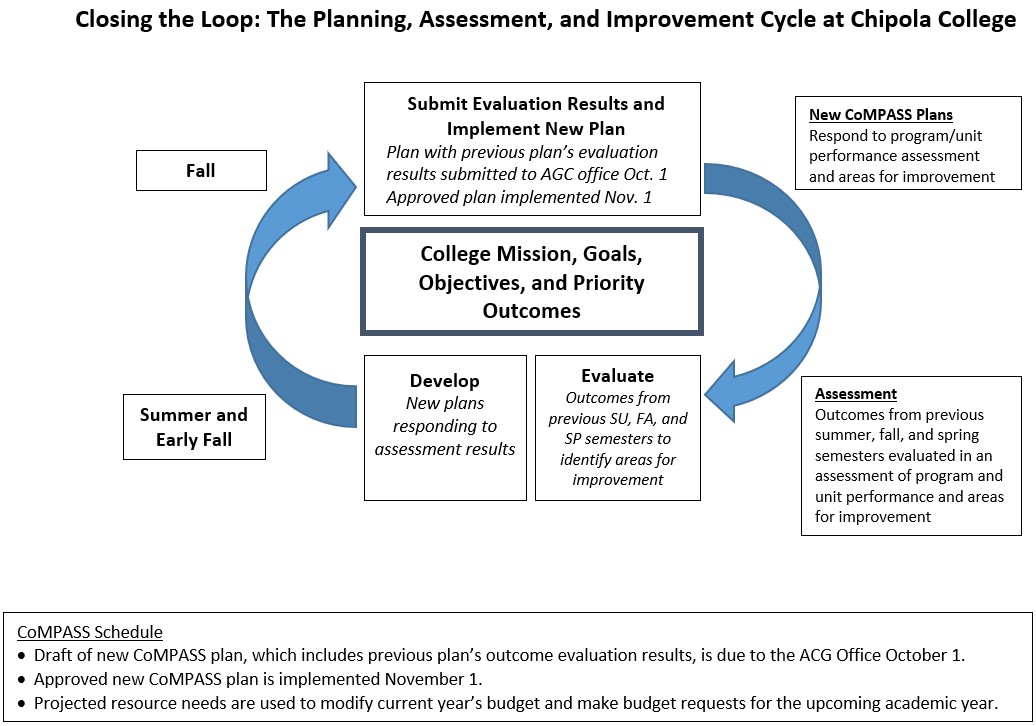Note: This document describes the planning process for educational programs, administrative units, and support units at Chipola College beginning the 2023 summer semester. Prior to that time, the planning cycle coincided with the academic year (fall through summer). The institutional planning cycle continues to follow the academic year.
The Chipola Model for Planning, Assessment, and Sustained Success
Chipola College has a proud tradition of academic excellence supported by an effective system of planning and evaluation. The Chipola Model for Planning, Assessment, and Sustained Success – CoMPASS – is the planning, evaluation, and improvement model for the institution and its educational programs, administrative units, and support units.
CoMPASS responds to policies established by the Chipola College District Board of Trustees. Policy 1.010 states that a philosophical goal of the Board is to establish “effective and efficient plans for achieving the long-range goals of the college….” Policy 1.020 charges the college president with developing and maintaining “a master plan for the college that includes goals and objectives, sets priorities, and allows for continuous evaluation after implementation.”
Through CoMPASS, the college complies with SACSCOC accreditation standards. Core Requirement 7.1: “The institution engages in ongoing, comprehensive, and integrated research-based planning and evaluation processes that (a) focus on institutional quality and effectiveness and (b) incorporate a systematic review of institutional goals and outcomes consistent with its mission.” Standard 7.3: “The institution identifies expected outcomes of its administrative support services and demonstrates the extent to which the outcomes are achieved.” Core Requirement 8.1: “The institution identifies, evaluates, and publishes goals and outcomes for student achievement appropriate to the institution’s mission, the nature of the students it serves, and the kinds of programs offered. The institution uses multiple measures to document student success.” Standard 8.2: The institution identifies expected outcomes, assesses the extent to which it achieves these outcomes, and provides evidence of seeking improvement based on analysis of the results in (a) student learning outcomes for each of its educational programs, (b) student learning outcomes for collegiate-level general education competencies of its undergraduate degree programs, and (c) academic and student services that support student success.
Institutional planning is one component of the CoMPASS model. The Institutional Planning and Accountability Committee analyzes college-wide assessment results and works with faculty and staff to develop a draft college master plan that is submitted to the college president for approval each fall semester. The master plan is aligned with the college mission and includes institutional goals, objectives, and priority outcomes. The institutional planning cycle is fall semester through summer semester, which coincides with the assessment timeframe for several major institutional outcomes (e.g., enrollment, retention, completion, job placement). The program/unit planning cycle is summer semester through spring semester as described in the following paragraph.
Planning at the program and unit levels is another component of the CoMPASS model. Following the spring semester, faculty and staff in educational programs, administrative units, and support units evaluate outcomes from the previous summer, fall, and spring semesters. Evaluation results are used to assess performance and develop improvement plans (CoMPASS plans). CoMPASS plans are submitted to the Assessment, Compliance, and Grants Office for approval October 1 and are implemented November 1. The new CoMPASS plans include the previous year’s evaluation results.
In the CoMPASS plans, faculty and staff identify the college priority outcomes that correspond with anticipated outcomes and strategies of the program or unit. Estimated costs of implementing the strategies are also identified in the CoMPASS plans. The cost estimates and performance in relation to strategies are monitored by the planners, modified if necessary, and are used in making budget requests for the program or unit the following spring.
By linking the CoMPASS plan anticipated outcomes, strategies, and budget needs to the college’s priority outcomes, the college ensures that the program and unit plans align with college resource allocations, support the college goals, and help accomplish the college mission.
CoMPASS “closes the loop” in the institutional, program, and unit planning cycles by basing improvement strategies on assessment results and identifying resources needed to implement those improvement strategies. The following graphic shows that planners from educational programs, administrative units, and support units develop their CoMPASS plans in the summer and early fall based on their assessment of evaluation data from the previous summer, fall, and spring semesters.

Updated: 4.11.2023
View the college's current master plan.

